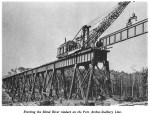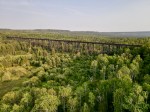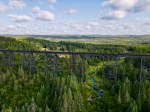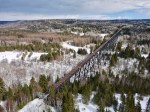Blende River Viaduct-Pass Lake Trestle
Pass Lake Station Blende River Viaduct Amethyst Station
The Blende River Viaduct, better known as the Pass Lake Trestle, is located just northwest of the community of Pass Lake, Ontario at Milepost 123.4/173.1.
While the Blende River is nothing more than a small creek (it is indicated as such on road signs), the valley through which it passed required the construction of a large structure. This was a direct result of the route that Canadian Northern was forced to select through the Pass Lake area.
The viaduct is 2258 feet long and the maximum height is 130 feet, making it the largest such structure in central Canada. It is comprised of 14 spans of 75 feet resting on 15 towers of 115 feet, with six 60-foot spans and four 40-foot towers at the ends. The foundations of the two abutments and end pedestals are on rock; the remaining pedestals are built upon pile foundations. The viaduct can support the weight of 180 ton locomotives arranged end-to-end along its entire length.
Under the direction of James A. Whalen, construction on the concrete substructure began on May 3, 1912, and was completed by July 30, 1912. Subcontractors Kennedy Construction Company poured approximately 3,600 cubic yards of concrete and utilized approximately 2,000 piles for the foundations. The steel superstructure was built by the Canadian Bridge Company of Walkerville, Ontario. The first span was placed on August 20, 1912, and the last span, or most easterly, was in position by December 28, 1912. The total of weight of steel for the spans and towers was approximately 5,000,000 pounds. The viaduct was designed under the supervision of Walter P. Chapman, Bridge Engineer, Mackenzie, Mann and Company and cost nearly $350,000 ($8-9 million in today’s dollars).
There was one verified accident during construction where a worker fell from the top of the structure in October 1912. Though he sustained serious injuries, landing in the soft muskeg in the valley saved him from certain death.
The first train passed over the trestle on January 14, 1913.
Until the 1970s, the speed limit for trains crossing the viaduct had been 30 miles per hour or greater. By 1976, the limit was suddenly dropped to 10 miles per hour. It has been suggested that this was due to the deterioration of the foundations of the structure. One source has reported that CN poured a considerable amount of concrete into the footings of some of the tower pads during this time to reinforce them. The efforts must have been successful as the speed limit was raised to 20 miles per hour by 1980.
- The viaduct under construction, 1912.
- The viaduct under construction, 1912.
- Canadian Bridge Company
- Port Arthur Daily News, October 23, 1912.
- Port Arthur Daily News, January 4, 1913.
- Port Arthur Daily News, May 3, 1913.
- The viaduct as completed, circa 1913.
- The viaduct as completed, circa 1913.
- Viaduct, June 2004. (J. Rice)
- Viaduct, October 2004. (J. Rice)
- Viaduct, October 2020.
- Viaduct, October 2020.
- Viaduct, April 2021.
- Viaduct, August 2021.
- Viaduct, August 2021.
- Viaduct, August 2021.
- Viaduct, August 2021.
- Viaduct, September 2021.
- Viaduct, October 2021.
- Viaduct, October 2021.
- Viaduct, October 2021.
- Viaduct, October 2021.
- Viaduct, March 2022.
This video contains information on the history of the viaduct and the entire rail line.
There are several videos of the viaduct in the YouTube playlist below.




















